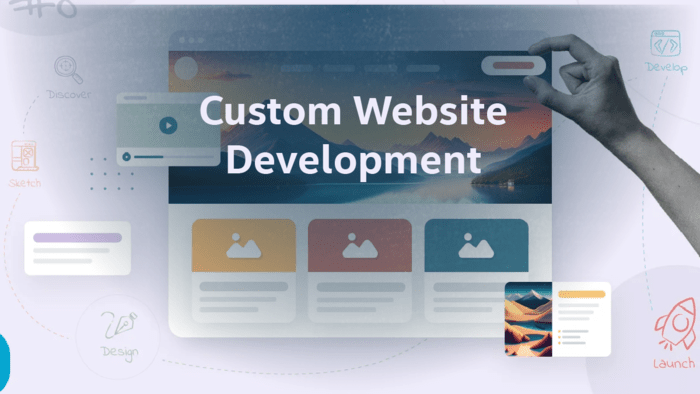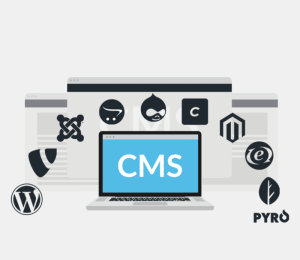
Custom Website Development Best Feature By Popcorn IT
– Custom-built websites tailored to meet specific business needs.
– Responsive design for seamless functionality across all devices.
– SEO optimization to improve search engine rankings and drive organic traffic.
– Focus on user experience (UX) to enhance visitor engagement and encourage conversions.
– Scalable architecture to accommodate business growth and increased traffic.
– Robust e-commerce integration for secure transactions and efficient inventory management.
– Implementation of user-friendly content management systems (CMS) for easy updates.
– Development of custom features and functionalities based on unique business requirements.
– Optimization of website speed and performance for a smooth user experience.
– Provision of ongoing support and maintenance services to ensure website security and functionality.
Tailored Solutions: In today’s digital landscape, a one-size-fits-all approach to web design & custom website development simply doesn’t cut it. This is where tailored solutions come into play, offering custom-built websites meticulously designed to meet the unique needs and goals of your business. Unlike generic templates, a custom website is crafted from the ground up, ensuring that every element aligns with your brand identity, target audience, and specific objectives.
The process begins with a thorough understanding of your business. We dive deep into your brand, your market, and your competition. This involves detailed consultations to gather insights into your vision, values, and the unique selling points that set you apart. By understanding your goals—whether it’s boosting online sales, generating leads, or enhancing brand awareness. we can create a blueprint for a website that truly resonates with your audience. One of the key advantages of a custom-built website is its adaptability. As your business evolves, so too can your website. Custom solutions offer scalability, meaning you can add new features, integrate advanced functionalities, and expand your digital presence without compromising performance or aesthetics. This is particularly crucial for businesses poised for growth, as it eliminates the need for frequent overhauls and ensures your website can grow in tandem with your ambitions.
Moreover, custom websites are designed with user experience (UX) at the forefront. By tailoring the design to your specific audience, we can create an intuitive and engaging journey that guides visitors seamlessly through your site. This involves strategic placement of call-to-action buttons, streamlined navigation, and a visually appealing layout that keeps users engaged. The result is not just a website that looks great, but one that performs exceptionally well, driving higher conversion rates and fostering customer loyalty. Search engine optimization (SEO) is another critical component of custom website development. A bespoke site is built with SEO best practices from the outset, ensuring your site is structured in a way that enhances visibility on search engines. This includes optimized code, fast load times, mobile responsiveness, and strategic keyword integration, all designed to improve your search engine rankings and attract more organic traffic.
In essence, custom website development is about creating a digital platform that is uniquely yours. It’s about ensuring every detail, from the design to the functionality, aligns perfectly with your business goals. With a custom-built website, you are not just getting a static online presence; you are investing in a dynamic tool that drives growth, engages customers, and sets you apart in the crowded digital marketplace.
Responsive Design : In the modern digital era, having a responsive design for your website is not just a luxury, but a necessity. Responsive design ensures that your website looks and functions seamlessly across all devices, including desktops, tablets, and smartphones. This adaptability is crucial given the diverse range of devices and screen sizes used by consumers today. A website that performs well on any device not only enhances user experience but also helps in retaining visitors and converting them into loyal customers. Responsive design starts with a fluid grid layout. Unlike fixed layouts that have specific pixel dimensions, a fluid grid allows elements on your website to resize and rearrange themselves based on the screen size. This means your website will maintain its structure and readability whether it’s being viewed on a large desktop monitor or a small smartphone screen. The fluidity of this design approach ensures that images, text, and interactive elements are displayed in an optimal manner without requiring users to zoom in or scroll excessively. In addition to the layout, responsive design also involves adaptive images. Images are a significant part of any website’s aesthetic and user experience. In a responsive design, images automatically adjust to fit the screen size and resolution of the device being used. This prevents images from appearing distorted or too large, which can disrupt the user experience.Using modern web technologies like CSS media queries, designers can specify different image sizes and formats to be loaded based on the device, ensuring fast load times and efficient use of bandwidth.
Moreover, navigation is a key element that benefits from responsive design. On a desktop, you might have a horizontal menu bar with dropdowns, but this format isn’t suitable for smaller screens. Responsive design reconfigures navigation menus into more user-friendly formats, such as hamburger menus or accordion-style lists, making it easy for users to find what they need regardless of the device they’re using. Responsive design also significantly impacts your website’s performance and search engine rankings. Search engines like Google prioritize mobile-friendly websites in their search results. A responsive website improves your SEO efforts by providing a consistent user experience and faster load times, which are factors that search engines consider when ranking websites. Additionally, managing a single responsive website is more cost-effective and less time-consuming than maintaining separate sites for desktop and mobile users. User experience (UX) is at the core of responsive design. A seamless and intuitive experience across all devices can dramatically increase user engagement and satisfaction. Visitors are more likely to stay longer on a site that is easy to navigate and visually appealing on any device. This extended engagement can lead to higher conversion rates, whether your goal is to generate leads, sell products, or provide information.
In summary, responsive design is essential for creating a versatile and efficient website. It ensure your website is accessible and functional on any device, enhancing user experience and boosting your search engine rankings. By adopting a responsive design approach, you invest in a future-proof solution that adapts to evolving technology and user preferences, providing a consistent and high-quality experience for all visitors.
SEO Optimization : In today’s competitive digital marketplace, Search Engine Optimization (SEO) is crucial for ensuring your website stands out and reaches its target audience. Developing websites with best practices in SEO is essential for improving search engine rankings and driving organic traffic. SEO is not just about integrating keywords; it’s a comprehensive strategy that encompasses various aspects of web development and content creation to enhance your site’s visibility on search engines like Google. A fundamental aspect of SEO optimization is the use of well-researched keywords and phrases that your target audience is likely to search for. By incorporating these keywords naturally into your website’s content, meta descriptions, headings, and image alt texts, you make it easier for search engines to understand the relevance of your pages to user queries. However, keyword stuffing should be avoided, as search engines penalize this practice. The key is to maintain a balance between optimization and readability. Another critical component of SEO is the website’s structure and navigation.
A well-organized site with a clear hierarchy helps search engines crawl and index your content more efficiently. This includes using proper header tags (H1, H2, H3) to outline the structure of your content, creating an XML sitemap to guide search engine crawlers, and ensuring that your URL structure is clean and descriptive. Internal linking is also important, as it helps distribute page authority and encourages visitors to explore more of your site. Page speed and mobile-friendliness are also vital for SEO. Search engines prioritize websites that load quickly and offer a seamless experience on mobile devices. Optimizing images, leveraging browser caching, and minimizing JavaScript can improve your site’s load times. Responsive design ensures that your website functions well on all devices, which is crucial as mobile traffic continues to grow. Quality content remains at the heart of SEO. Regularly updating your site with informative, engaging, and original content can attract more visitors and encourage them to stay longer. This not only boosts your site’s authority but also increases the chances of earning backlinks from other reputable sites, further enhancing your search engine ranking.
In summary, developing websites with best practices in SEO involves a multifaceted approach that includes keyword optimization, structured content, fast load times, mobile responsiveness, and high-quality content. By implementing these strategies, you can improve your search engine rankings, attract more organic traffic, and ultimately achieve your business objectives.
User Experience (UX) Focused : Focusing on User Experience (UX) is essential for creating websites that not only attract visitors but also keep them engaged and encourage conversions. An intuitive and engaging user experience ensures that your site is easy to navigate, visually appealing, and tailored to meet the needs of your target audience. Starting with a clear, logical layout is key. This involves strategically placing elements like menus, buttons, and content sections where users naturally expect to find them. Simplified navigation and an uncluttered interface help users find information quickly and efficiently, reducing frustration and bounce rates. Visual appeal is another crucial aspect of UX. Using a cohesive color scheme, high-quality images, and readable fonts enhances the overall aesthetic of your site, making it more inviting. Interactive elements such as animations, hover effects, and dynamic content can further engage visitors and make their experience memorable.
Additionally, responsive design ensures that your site offers a consistent experience across all devices, from desktops to smartphones. Fast load times and mobile-friendly layouts are essential to keeping users engaged, as slow, unresponsive sites quickly drive visitors away. By prioritizing UX, you create a website that not only attracts visitors but also keeps them engaged, leading to longer site visits and higher conversion rates.
Scalable Architecture : Designing websites with scalable architecture is crucial for supporting the growth of your business. Scalable architecture ensures that your website can handle increased traffic and integrate new functionalities as your business expands. This involves using flexible technologies and modular design principles, allowing for easy updates and additions without disrupting existing operations. A well-designed scalable website can accommodate surges in user activity, maintain fast load times, and deliver a consistent user experience. By planning for scalability from the outset, you ensure that your website remains robust, adaptable, and capable of meeting the evolving demands of your business and customers.
E-commerce Integration : Building robust e-commerce platforms involves integrating secure payment gateways, effective inventory management systems, and creating a seamless shopping experience. Secure payment gateways are essential to protect customer data and build trust, ensuring smooth and safe transactions. Efficient inventory management keeps track of stock levels in real-time, preventing overselling and managing supply chains effectively.
Additionally, a user-friendly interface with intuitive navigation, fast load times, and responsive design enhances the shopping experience, encouraging repeat customers. By combining these elements, you create a comprehensive e-commerce solution that supports your business growth, meets customer expectations, and drives sales.
Content Management Systems (CMS): Implementing easy-to-use Content Management Systems (CMS) like WordPress, Joomla, or custom solutions is
 essential for effortless content updates and efficient website management. These platforms empower users to create, edit, and manage content without requiring extensive technical knowledge, making it accessible for businesses of all sizes. WordPress is renowned for its user-friendly interface and extensive library of plugins, which allow for a high degree of customization and functionality. Its intuitive dashboard makes it simple to update pages, publish blog posts, and manage media files. Similarly, Joomla offers robust features and flexibility, catering to more complex website structures and advanced user management, while still maintaining ease of use. For businesses with specific needs, custom CMS solutions can be developed to provide a tailored experience. These bespoke systems are designed with the exact functionalities and workflows that match your business processes, ensuring maximum efficiency and usability. Custom CMS platforms can integrate seamlessly with other business tools, enhancing overall productivity and streamlining operations. Regardless of the CMS chosen, key features like drag-and-drop editors, version control, and user roles and permissions contribute to a smoother content management experience. These features enable multiple team members to collaborate effectively, ensuring content is up-to-date, consistent, and aligned with your brand’s voice.
essential for effortless content updates and efficient website management. These platforms empower users to create, edit, and manage content without requiring extensive technical knowledge, making it accessible for businesses of all sizes. WordPress is renowned for its user-friendly interface and extensive library of plugins, which allow for a high degree of customization and functionality. Its intuitive dashboard makes it simple to update pages, publish blog posts, and manage media files. Similarly, Joomla offers robust features and flexibility, catering to more complex website structures and advanced user management, while still maintaining ease of use. For businesses with specific needs, custom CMS solutions can be developed to provide a tailored experience. These bespoke systems are designed with the exact functionalities and workflows that match your business processes, ensuring maximum efficiency and usability. Custom CMS platforms can integrate seamlessly with other business tools, enhancing overall productivity and streamlining operations. Regardless of the CMS chosen, key features like drag-and-drop editors, version control, and user roles and permissions contribute to a smoother content management experience. These features enable multiple team members to collaborate effectively, ensuring content is up-to-date, consistent, and aligned with your brand’s voice.
Moreover, implementing a CMS with strong SEO capabilities is vital for improving your website’s visibility on search engines. Many CMS platforms offer built-in tools and plugins for optimizing metadata, generating XML sitemaps, and managing keywords, which are crucial for enhancing search engine rankings. By leveraging an easy-to-use CMS, you can maintain a dynamic and current website that responds quickly to market changes, engages visitors with fresh content, and supports your overall digital strategy. This not only improves user experience but also contributes significantly to your online presence and business growth.
Custom Features : Developing bespoke features and functionalities tailored to your specific business requirements ensures your website meets unique operational needs. Custom features can range from sophisticated booking systems and dynamic e-commerce solutions to interactive tools and personalized user experiences. By designing these functionalities specifically for your business, you enhance efficiency, user engagement, and overall site performance. These tailored solutions allow for seamless integration with existing systems, providing a cohesive digital ecosystem that supports your business processes. Custom features not only set your website apart from competitors but also offer flexibility to adapt and scale as your business evolves, ensuring long-term relevance and effectiveness.
High Performance: Ensuring high performance for your website involves optimizing speed and overall functionality to guarantee fast load times and a seamless user experience. This optimization effort is critical for retaining visitor interest and reducing bounce rates. By implementing strategies such as efficient code optimization, browser caching, and content delivery network (CDN) integration, your website can deliver content swiftly, regardless of the user’s location or device.
Additionally, optimizing image sizes, minimizing HTTP requests, and leveraging browser caching further enhance website performance. By prioritizing high performance, you not only improve user satisfaction but also boost search engine rankings, as speed is a crucial factor in search algorithms.
Ongoing Support and Maintenance: Offering ongoing support and maintenance services is essential for ensuring that your website remains up-to-date, secure, and consistently operational. This continuous support guarantees that your website evolves alongside technological advancements and changing security threats. Regular updates are crucial for addressing vulnerabilities, fixing bugs, and implementing new features. By staying proactive in software updates, plugins, and security patches, you mitigate risks and maintain optimal website performance. Moreover, ongoing maintenance includes monitoring website performance, identifying potential issues, and implementing solutions to prevent downtime. Security is paramount, and regular security audits, malware scans, and firewall configurations are integral components of ongoing support. By implementing robust security measures and staying vigilant against potential threats, you safeguard sensitive data and protect your website from cyberattacks.
Furthermore, providing responsive customer support ensures that any issues or concerns are addressed promptly, fostering trust and satisfaction among users. Ultimately, ongoing support and maintenance services are essential investments in the long-term success and reliability of your website, ensuring it remains a valuable asset for your business.
Conclusion: In conclusion, custom website development services offer a tailored solution to businesses and individuals seeking a unique online presence. These services provide flexibility, allowing clients to articulate their specific needs and preferences, resulting in a website that aligns closely with their brand identity and objectives. Through custom development, businesses can differentiate themselves from competitors, enhance user experience, and achieve their goals more effectively. Moreover, custom websites are scalable and adaptable, capable of accommodating future growth and evolving requirements. While custom website development may require a higher initial investment compared to off-the-shelf solutions, the long-term benefits in terms of functionality, performance, and branding often outweigh the costs. Additionally, working with experienced professionals ensures a high-quality end product that reflects the client’s vision and meets the demands of modern web standards.
In today’s digital landscape, where a strong online presence is crucial for success, investing in custom website development services can be a strategic decision that pays dividends in the form of increased traffic, engagement, and ultimately, business growth.

